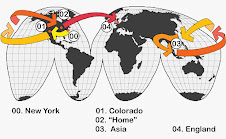 Those baskets in the boat are full of ducks...
Those baskets in the boat are full of ducks...
I hate to tell you, but we are not as adventurous as you thought. Well, maybe, but we did end up taking the "typical" loop through Myanmar which includes Bagan, Mandalay, Inle Lake, and Yangon. Does it help that maybe you haven't heard of any of these places before? It's actually fairly difficult (on our time and money budget) to travel beyond these places, with a few small loops North or South as an exception. We kept trying to make a stop somewhere, only to discover that the buses go from point A in the evening and arrive at point B in the morning, so we would still have to pay for A to B and get off at some early-morning hour mid-route and try to catch the same bus (again paying for A to B) early some later morn, praying the bus would stop and no one had claimed our seats. The alternative is to hire a car/driver, but that whole budget thing got in the way... All that being said, we did our loop with three overnight buses and a very long, bumpy, non-AC day bus, and still enjoyed Myanmar immensely!
Oh, right, this post was actually about Inle.
Inle Lake is a big-ish, shallow lake nestled in the mountains. We stayed in the nearby village of Nyaung Shwe in one of our favorite hotel rooms- big, airy, ceiling fan, pretty dark woven bamboo walls, bathroom attached (I really am planning a post on hotels and bathrooms, Mom). Electricity was just as spotty as it was in Mandalay, but with cooler weather, it really didn't matter.

Nyaung Shwe was full of monasteries and temples. Most Burmese men are monks twice in their lives and many women become nuns for a time. This line of nuns-all children- went from restaurant to restaurant singing for donations of food. We'll try to upload the video because it's pretty cool.
 We spent one day taking a boat tour of the many local craft shops, monasteries, stilt villages, and floating gardens, and another day biking around the lake to a market. On the lake, much energy was spent collecting seaweed (above)...
We spent one day taking a boat tour of the many local craft shops, monasteries, stilt villages, and floating gardens, and another day biking around the lake to a market. On the lake, much energy was spent collecting seaweed (above)... ... in order to make floating gardens. Tomatoes were especially popular. Tending and picking are done by boat.
... in order to make floating gardens. Tomatoes were especially popular. Tending and picking are done by boat.
 Most of the villages are networks of canals and bridges, which our driver kindly led us through.
Most of the villages are networks of canals and bridges, which our driver kindly led us through. The crafts we saw were silver smithing, umbrella making, paper making, weaving (cotton, silk, and lotus), and cigar making. This women is preparing silk thread for weaving.
The crafts we saw were silver smithing, umbrella making, paper making, weaving (cotton, silk, and lotus), and cigar making. This women is preparing silk thread for weaving. I thought all these dyes looked interesting. We saw looms in Vietnam, but this system, while extensive, seemed much more "home-grown." The looms were hand-powered and the dyeing was done in large pots over a charcoal fire.
I thought all these dyes looked interesting. We saw looms in Vietnam, but this system, while extensive, seemed much more "home-grown." The looms were hand-powered and the dyeing was done in large pots over a charcoal fire.
The markets rotate through lake-side villages on a 5-day cycle, but we happened to take a boat trip on the full moon day- when the market-cycle takes a break for meditation. The bikes we rented were even worse than the Bagan ones, with horrible seats and non-existent brakes. But the bumpy ride was on red-dirt, tree-lined paths through canals and emerald green rice paddies or fields of sunflowers fringed with blue mountains and white, low-laying clouds, with views of the occasional stilt village and rusty temple or monastery. We had to set out by 6:45 to make it to the market in time, but it was well-worth getting up early. This man is preparing betel nuts wrapped in leaves at the market. Everyone chews these things, which make your teeth and gums look all red and bloody. The streets are stained with dark red spit...
This man is preparing betel nuts wrapped in leaves at the market. Everyone chews these things, which make your teeth and gums look all red and bloody. The streets are stained with dark red spit...

A market view.



1 comment:
Your pictures are stunning! (both macro and ordinary)
I love the water filtration bucket. That looked brilliant!
Post a Comment